简体中文
繁體中文
English
Pусский
日本語
ภาษาไทย
Tiếng Việt
Bahasa Indonesia
Español
हिन्दी
Filippiiniläinen
Français
Deutsch
Português
Türkçe
한국어
العربية
Doomsday Clock frozen at two minutes to apocalypse
Abstract:Media playback is unsupported on your deviceMedia captionThe CEO of Bulletin of the Atomic Scientist

Media playback is unsupported on your device
Media captionThe CEO of Bulletin of the Atomic Scientists explained why the clock was unchanged
The "new abnormal" the world is facing from risks like nuclear war and climate change has led the symbolic Doomsday Clock to be frozen at the closest it has ever been to midnight.
The clock, created by the Bulletin of the Atomic Scientists (BAS) in 1947, intends to warn of impending disasters.
Its 2019 setting was announced on Thursday - staying in the same perilous position it was set at last year.
The BAS has warned we are "normalising a very dangerous world".
It marks only the third year the clock has been so close to midnight - first reaching the position in 1953 after the US and the Soviet Union tested highly destructive hydrogen bombs.
Why has it stayed the same?
In Thursday's announcement in Washington, representatives from the Bulletin said the clock's maintained position was "bad news indeed".
"Though unchanged from 2018, this setting should be taken not as a sign of stability but as a stark warning to leaders and citizens around the world," BAS President and CEO, Rachel Bronson, said.
"This new abnormal is simply too volatile and too dangerous to accept," Ms Bronson warned at the unveiling.
Former California governor Jerry Brown, who serves as BAS executive chair, also cautioned: "We're playing Russian roulette with humanity."
In the announcement, the bulletin did acknowledge improvements in US-North Korean relations, but also criticised developments like increased carbon emissions from some nations and continued diplomatic schisms across the world.
The group cites nuclear weapons and climate change as the two major ongoing threats to mankind - and warned their risks were being "exacerbated" by the "increased use of information warfare to undermine democracy around the world".
Image copyrightGetty ImagesImage caption The clock (photographed in 2018) has stayed the same
Herb Lin, a senior research scholar for cyber policy and security from Stanford University, spoke about the particular risks from "fake news" at Thursday's announcement.
"It's a terrible world in which rage and fantasy replace truth," he cautioned.
When it debuted the clock's hand stood at seven minutes to midnight and it has been reset 23 times since.
According to the Bulletin, its design was conceived by artist Martyl Langsdorf.
She wanted to illustrate impassioned observations she had heard from scientists about the consequences of the world's first atomic weapons, which they helped develop.
Today, the board - made up of physicists and environmental scientists from around the world - decides whether to adjust the clock in consultation with the group's Board of Sponsors, which include Nobel laureates.
Disclaimer:
The views in this article only represent the author's personal views, and do not constitute investment advice on this platform. This platform does not guarantee the accuracy, completeness and timeliness of the information in the article, and will not be liable for any loss caused by the use of or reliance on the information in the article.
WikiFX Broker
Latest News
How Sentiment Analysis Powers Winning Forex Trades in 2024
Capital One Faces Potential CFPB Action Over Savings Account Disclosures
Malaysian Woman's RM80,000 Investment Dream Turns into a Nightmare
Social Media Investment Scam Wipes Out RM450k Savings
FP Markets Received Three Major Awards
One article to understand the policy differences between Trump and Harris
M2FXMarkets Review 2024: Read Before You Trade
FX SmartBull Review! Read first, then Invest
Bangladesh steps up payments to Adani Power to avoid supply cut
Bitcoin.com Introduces Venmo for U.S. Bitcoin Purchases via MoonPay
Currency Calculator


